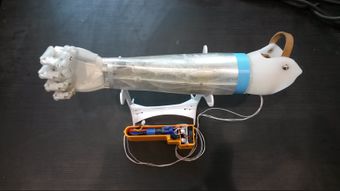"Bionic hand prosthesis"
The hands are main parts of the human body that allow us to interact with the environment. The loss of one limb leads to a great discomfort in everyday life.
Loss of both limbs makes a person disabled. Therefore, the task of replacing a missing limb is very important today. According to the modern science, the development of electromechanical prosthesis that have a strong resemblance to the appearance and functionality of natural limbs is the most possible option.
Aims of the project
The aims of this work are to develop bionic prosthesis able to compensate the lossof limbs; to develop control system based on registration of muscle activity; to develop a control system based on determining the prosthesis orientation; to develop a tactile feedback. We use 3D printing and the latest researches in MEMS (microelectromechanical systems) technologies.
Hand mechanics
The main conditions imposed on the prosthesis mechanics are: independent finger movement (flexion / extension); the possibility of taking an oversized (cup) and small items (plastic card / coin); the possibility of making a rotary hand movement. The work period without recharging should be at least twelve hours, a hand should be very natural. In this study we developed a prototype that has 6 degrees of freedom: each finger flexes / unbends independently from the others, the rotating degree of freedom of hands have been implemented with the forearm around the mounting sleeve to the patient's hand (blue detail, Illustration 1). Fingers are driven by servo Impact IS45MGD (shaft torque is 10kgs / sm, the speed of shaft rotation at 60 degrees is equal to 0.08 sec). Power transmission from a servomotor to the finger is carried out by pulling the threads, which fastening at one end to the tip of the finger, at the other end to the motor shaft. Two propulsions were laid on each finger (one of these works on flexion, the second works on extension). By rotating the engine in one direction the first strand is wound and the other is unwound. As a result, the finger flexes and unbends during the rotation in the opposite direction. The hand is manufactured using 3D printing technology. The palm and cladding structure are made of T-Glass plastic (polyethylenterephtalate glycol is modified; the tensile strength is 55-75 N / mm2).
